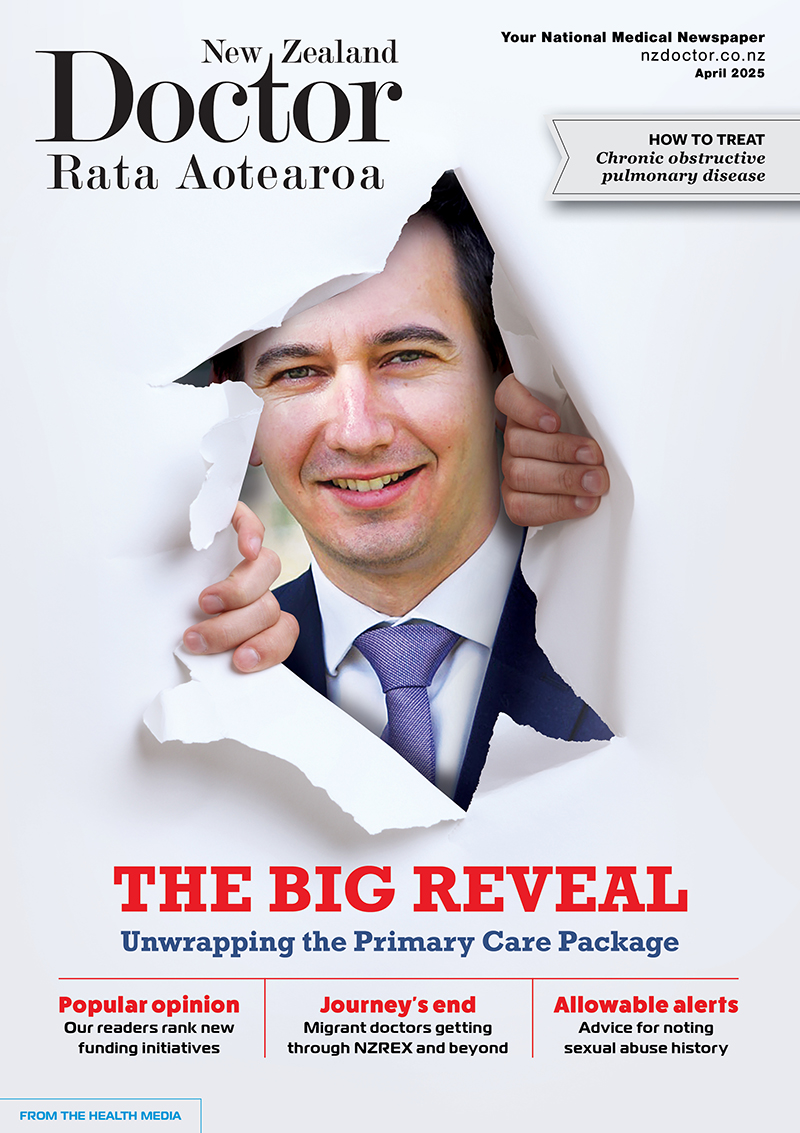Respiratory physician Lutz Beckert considers chronic obstructive pulmonary disease management, including the prevention of COPD, the importance of smoking cessation and pulmonary rehabilitation, and the lifesaving potential of addressing treatable traits. He also discusses the logic of inhaler therapy, moving from single therapy to dual and triple therapy when indicated, as well as other aspects of management
Mānuka honey as a medicine
Mānuka honey as a medicine

Pharmacist and medical herbalist Phil Rasmussen examines the latest scientific research on the medicinal properties of mānuka honey, including potential applications in wound care, infection management, and the prevention and treatment of cancer
Kia ora and welcome to New Zealand Doctor Rata Aotearoa
Not a subscriber? Unlock this article by subscribing here.
1. Zaidi MZ, Sharma J. Honey and its beneficial therapeutic effects: A review. J Pharmacogn Phytochem 2019;8(4):1056–61.
2. Nikhat S, Fazil M. History, phytochemistry, experimental pharmacology and clinical uses of honey: A comprehensive review with special reference to Unani medicine. J Ethnopharmacol 2022;282:114614.
3. Aw Yong PY, Islam F, Harith HH, et al. The potential use of honey as a remedy for allergic diseases: A mini review. Front Pharmacol 2021;11:599080.
4. Jodidio M, Schwartz RA. Honey therapies for dermatological disorders: more than just a sweet elixir. Int J Dermatol 2024;63(4):422–30.
5. Khataybeh B, Jaradat Z, Ababneh Q. Anti-bacterial, anti-biofilm and anti-quorum sensing activities of honey: A review. J Ethnopharmacol 2023;317:116830.
6. Palma-Morales M, Huertas JR, Rodríguez-Pérez C. A comprehensive review of the effect of honey on human health. Nutrients 2023;15(13):3056.
7. Abuelgasim H, Albury C, Lee J. Effectiveness of honey for symptomatic relief in upper respiratory tract infections: a systematic review and meta-analysis. BMJ Evid Based Med 2021;26(2):57–64.
8. Rasmussen PL. Herbal monograph: Manuka (Leptospermum scoparium). Phytonews 1998;1.
9. Riley M. Māori Healing and Herbal. Viking Sevenseas New Zealand; 1994.
10. Mathew C, Tesfaye W, Rasmussen P, et al. Mānuka oil – A review of antimicrobial and other medicinal properties. Pharmaceuticals (Basel) 2020;13(11):343.
11. Wang S, Qiu Y, Zhu F. An updated review of functional ingredients of Manuka honey and their value-added innovations. Food Chem 2024;440:138060.
12. Allen KL, Molan PC, Reid GM. A survey of the antibacterial activity of some New Zealand honeys. J Pharm Pharmacol 1991;43(12):817–22.
13. Willix DJ, Molan PC, Harfoot CG. A comparison of the sensitivity of wound-infecting species of bacteria to the antibacterial activity of manuka honey and other honey. J Appl Bacteriol 1992;73(5):388–94.
14. al Somal N, Coley KE, Molan PC, et al. Susceptibility of Helicobacter pylori to the antibacterial activity of manuka honey. J R Soc Med 1994;87(1):9–12.
15. Oelschlaegel S, Gruner M, Wang PN, et al. Classification and characterization of manuka honeys based on phenolic compounds and methylglyoxal. J Agric Food Chem 2012;25:60(29):7229–37.
16. Shan Y. Medicinal honey in clinical practice: viable alternative or useful adjunct in wound care management? Br J Nurs 2019;28(12):S23–30.
17. Gethin G, Cowman S. Bacteriological changes in sloughy venous leg ulcers treated with manuka honey or hydrogel: an RCT. J Wound Care 2008;17(6):241–47.
18. Kamaratos AV, Tzirogiannis KN, Iraklianou SA, et al. Manuka honey-impregnated dressings in the treatment of neuropathic diabetic foot ulcers. Int Wound J 2014;11(3):259–63.
19. Sankar J, Lalitha AV, Rameshkumar R, et al. Use of honey versus standard care for hospital-acquired pressure injury in critically ill children: A multicenter randomized controlled trial. Pediatr Crit Care Med 2021;22(6):e349–62.
20. Onyango LA, Liang J. Manuka honey as a non-antibiotic alternative against Staphylococcus spp. and their small colony variant (SCVs) phenotypes. Front Cell Infect Microbiol 2024;14:1380289.
21. Bashir I, Rasool MH, Shafique M, et al. Exploring the antimicrobial efficacy of Manuka honey against multidrug-resistant and extensively drug-resistant Salmonella Typhi causing septicemia in Pakistan. Future Microbiol 2024;19(16):1377–87.
22. Bukhari MA, Qamash RA, Bulkhi RA, et al. Biological studies of the activity of Manuka honey against Carbapenem-resistant Enterobacterales (CRE) bacteria. Saudi Med J 2024;45(9):876–87.
23. Dahiya D, Mackin C, Nigam PS. Studies on bioactivities of Manuka and regional varieties of honey for their potential use as natural antibiotic agents for infection control related to wound healing and in pharmaceutical formulations. AIMS Microbiol 2024;10(2):288–310.
24. Xu L, Wang X, Wu Y, et al. Effectiveness of APG and honey gauze in pressure injury of elderly: A randomized control trial. Int J Low Extrem Wounds 2024; 25 February online.
25. Uddduttula A, Jakubovics N, Khan I, et al. Layer-by-layer coatings of collagen-hyaluronic acid loaded with an antibacterial manuka honey bioactive compound to fight metallic implant infections. ACS Appl Mater Interfaces 2023;15(50):58119–35.
26. Boekema BKHL, Chrysostomou D, Ciprandi G, et al. Comparing the antibacterial and healing properties of medical-grade honey and silver-based wound care products in burns. Burns 2024;50(3):597–610.
27. Harrison F, Blower A, de Wolf C, et al. Sweet and sour synergy: exploring the antibacterial and antibiofilm activity of acetic acid and vinegar combined with medical-grade honeys. Microbiology (Reading) 2023;169(7):001351.
28. Negut I, Grumezescu V, Grumezescu AM. Treatment strategies for infected wounds. Molecules 2018;23(9):2392.
29. Minden-Birkenmaier BA, Bowlin GL. Honey-based templates in wound healing and tissue engineering. Bioengineering (Basel) 2018;5(2):46.
30. Felbaum DR, Dowlati E, Jacobs M, et al. Mānuka honey: Feasibility and safety in postoperative neurosurgical wound care. Adv Skin Wound Care 2021;34(5):249–53.
31. Hbibi A, Sikkou K, Khedid K, et al. Antimicrobial activity of honey in periodontal disease: a systematic review. J Antimicrob Chemother 2020;75(4):807–26.
32. Onuoha EO, Adekunle AA, Ajike SO, et al. Effect of manuka honey socket dressing on postoperative sequelae and complications following third molar extraction: A randomized controlled study. J Craniomaxillofac Surg 2023;51(4):252–60.
33. Muhrbeck M, Wladis A, Lampi M, et al. Efficacy of topical honey compared to systemic gentamicin for treatment of infected war wounds in a porcine model: A non-inferiority experimental pilot study. Injury 2022;53(2):381–92.
34. van Riel SJJM, Lardenoije CMJG, Wassen MMLH, et al. Efficacy of a medical grade honey formulation (L-Mesitran) in comparison with fluconazole in the treatment of women with recurrent vulvovaginal candidiasis: protocol for a randomised controlled trial (HONEY STUDY). BMJ Open 2023;13(8):e070466.
35. Othman N. Honey and cancer: sustainable inverse relationship particularly for developing nations – a review. Evid Based Complement Alternat Med 2012;2012:410406.
36. Jaganathan S, Balaji A, Vellayappan M, et al. A review on anti-proliferative and apoptotic activities of natural honey. Anticancer Agents Med Chem 2015;15(1):48–56.
37. Erejuwa O, Sulaiman S, Wahab M. Effects of honey and its mechanisms of action on the development and progression of cancer. Molecules 2014;19(2):2497–522.
38. Subramanian A, John A, Vellayappan M, et al. Honey and its phytochemicals: Plausible agents in combating colon cancer through its diversified actions. Journal of Food Biochemistry 2016;40(4):613–29.
39. Waheed M, Hussain MB, Javed A, et al. Honey and cancer: A mechanistic review. Clin Nutr 2019;38(6):2499–503.
40. Eteraf-Oskouei T, Najafi M. Uses of natural honey in cancer: An updated review. Adv Pharm Bull 2022;12(2):248–61.
41. Jaganathan S, Mandal M. Anti-proliferative effects of honey and of its polyphenols: a review. J Biomed Biotechnol 2009;2009:830616.
42. Bose D, Famurewa A, Akash A, et al. The therapeutic mechanisms of honey in mitigating toxicity from anticancer chemotherapy toxicity: A review. J Xenobiot 2024;14(3):1109–29.
43. Gribel N, Pashinskiĭ V. [The antitumor properties of honey.] Vopr Onkol 1990;36(6):704–09.
44. Kassi E, Chinou I, Spilioti E, et al. A monoterpene, unique component of thyme honeys, induces apoptosis in prostate cancer cells via inhibition of NF-κB activity and IL-6 secretion. Phytomedicine 2014;21(11):1483–89.
45. Badolato M, Carullo G, Cione E, et al. From the hive: Honey, a novel weapon against cancer. Eur J Med Chem 2017;142:290–99.
46. Kadir E, Sulaiman S, Yahya N, et al. Inhibitory effects of Tualang Honey on experimental breast cancer in rats: a preliminary study. Asian Pac J Cancer Prev 2013;14(4):2249–54.
47. Kocyigit A, Aydogdu G, Balkan E, et al. Quercus pyrenaica honeydew honey with high phenolic contents cause DNA damage, apoptosis, and cell death through generation of reactive oxygen species in gastric adenocarcinoma cells. Integr Cancer Ther 2019;18:1534735419876334.
48. Fauzi A, Norazmi M, Yaacob N. Tualang honey induces apoptosis and disrupts the mitochondrial membrane potential of human breast and cervical cancer cell lines. Food Chem Toxicol 2011;49(4):871–78.
49. Hegazi N, Elghani G, Farag M. The super-food Manuka honey, a comprehensive review of its analysis and authenticity approaches. J Food Sci Technol 2022;59(7):2527–34.
50. Ahmed S, Othman N. The anti-cancer effects of Tualang honey in modulating breast carcinogenesis: an experimental animal study. BMC Complement Altern Med 2017;17(1):208.
51. Swellam T, Miyanaga N, Onozawa M, et al. Antineoplastic activity of honey in an experimental bladder cancer implantation model: in vivo and in vitro studies. Int J Urol 2003;10(4):213–19.
52. Jaganathan S, Mondhe D, Wani Z, et al. Effect of honey and eugenol on Ehrlich ascites and solid carcinoma. J Biomed Biotechnol 2010;2010:989163.
53. Fernandez-Cabezudo M, El-Kharrag R, Torab F, et al. Intravenous administration of manuka honey inhibits tumor growth and improves host survival when used in combination with chemotherapy in a melanoma mouse model. PLoS One 2013;8(2):e55993.
54. Idriss I, Ali A, Alam A, et al. Differential in vitro cytotoxic effects and metabolomic insights into raw and powdered Manuka honey through UPLC-Q-TOF-MS. Sci Rep 2024;14(1):17551.
55. Masad RJ, Idriss I, Mohamed YA, et al. Oral administration of Manuka honey induces IFNγ-dependent resistance to tumor growth that correlates with beneficial modulation of gut microbiota composition. Front Immunol 2024;15:1354297.
56. Ahmed S, Sulaiman S, Othman N. Oral administration of tualang and manuka honeys modulates breast cancer progression in sprague-dawley rats model. Evid Based Complement Alternat Med 2017;2017:5904361.
57. Márquez-Garbán DC, Yanes CD, Llarena G, et al. Manuka honey inhibits human breast cancer progression in preclinical models. Nutrients 2024;16(14):2369.
58. Afrin S, Giampieri F, Gasparrini M, et al. The inhibitory effect of Manuka honey on human colon cancer HCT-116 and LoVo cell growth. Part 1: the suppression of cell proliferation, promotion of apoptosis and arrest of the cell cycle. Food Funct 2018;9(4):2145–57.
59. Cianciosi D, Forbes-Hernandez T, Armas Diaz Y, et al. Manuka honey’s anti-metastatic impact on colon cancer stem-like cells: unveiling its effects on epithelial-mesenchymal transition, angiogenesis and telomere length. Food Funct 2024;15(13):7200–13.
60. Cianciosi D, Armas Diaz Y, Alvarez-Suarez J, et al. Can the phenolic compounds of Manuka honey chemosensitize colon cancer stem cells? A deep insight into the effect on chemoresistance and self-renewal. Food Chem 2023;427:136684.
61. Cianciosi D, Forbes-Hernández T, Regolo L, et al. Manuka honey in combination with 5-fluorouracil decreases physical parameters of colonspheres enriched with cancer stem-like cells and reduces their resistance to apoptosis. Food Chem 2022;374:131753.
62. Abel S, Dadhwal S, Gamble AB, et al. Honey reduces the metastatic characteristics of prostate cancer cell lines by promoting a loss of adhesion. PeerJ 2018;6:e5115.
63. Gasparrini M, Afrin S, Forbes-Hernández T, et al. Protective effects of Manuka honey on LPS-treated RAW 264.7 macrophages. Part 2: Control of oxidative stress induced damage, increase of antioxidant enzyme activities and attenuation of inflammation. Food Chem Toxicol 2018;120:578–87.
64. Hamad R, Jayakumar C, Ranganathan P, et al. Honey feeding protects kidney against cisplatin nephrotoxicity through suppression of inflammation. Clin Exp Pharmacol Physiol 2015;42(8):843–48.
65. Al Jaouni S, Al Muhayawi M, Hussein A, et al. Effects of honey on oral mucositis among pediatric cancer patients undergoing chemo/radiotherapy treatment at King Abdulaziz University Hospital in Jeddah, Kingdom of Saudi Arabia. Evid Based Complement Alternat Med 2017;2017:5861024.
66. Jahanbani Mazraeh E, Sadighi S, Manifar S, et al. Assessment of thyme honey oral gel for the prevention of adriamycin and cyclophosphamide chemotherapy-induced oral mucositis in patients with breast cancer. Support Care Cancer 2023;31(8):497.
67. Maddocks-Jennings W, Wilkinson JM, Cavanagh HM, et al. Evaluating the effects of the essential oils Leptospermum scoparium (manuka) and Kunzea ericoides (kanuka) on radiotherapy induced mucositis: a randomized, placebo controlled feasibility study. Eur J Oncol Nurs 2009;13(2):87–93.
68. Badr LK, El Asmar R, Hakim S, et al. The efficacy of honey or olive oil on the severity of oral mucositis and pain compared to placebo (standard care) in children with leukemia receiving intensive chemotherapy: A randomized controlled trial (RCT). J Pediatr Nurs 2023;70:e48–53.
69. Andriakopoulou C, Yapijakis C, Koutelekos I, et al. Prevention and treatment of oral mucositis in pediatric patients: Systematic review and meta-analysis of randomized controlled trials. In Vivo 2024;38(3):1016–29.
70. Braguês R, Marvão M, Correia P, et al. Oral mucositis management in children under cancer treatment: A systematic review. Cancers (Basel) 2024;16(8):1548.
71. Badders J, Coblens O, Ranasinghe V, et al. Medical honey in head and neck cancer. Cureus 2024;16(1):e52822.




![Barbara Fountain, editor of New Zealand Doctor Rata Aotearoa, and Paul Hutchison, GP and senior medical clinician at Tāmaki Health [Image: Simon Maude]](/sites/default/files/styles/thumbnail_cropped_100/public/2025-03/Barbara%20Fountain%2C%20editor%20of%20New%20Zealand%20Doctor%20Rata%20Aotearoa%2C%20and%20Paul%20Hutchison%2C%20GP%20and%20senior%20medical%20clinician%20at%20T%C4%81maki%20Health%20CR%20Simon%20Maude.jpg?itok=-HbQ1EYA)
![Lori Peters, NP and advanced health improvement practitioner at Mahitahi Hauora, and Jasper Nacilla, NP at The Terrace Medical Centre in Wellington [Image: Simon Maude]](/sites/default/files/styles/thumbnail_cropped_100/public/2025-03/2.%20Lori%20Peters%2C%20NP%20and%20advanced%20HIP%20at%20Mahitahi%20Hauora%2C%20and%20Jasper%20Nacilla%2C%20NP%20at%20The%20Terrace%20Medical%20Centre%20in%20Wellington%20CR%20Simon%20Maude.jpg?itok=sUfbsSF1)
![Ministry of Social Development health and disability coordinator Liz Williams, regional health advisors Mary Mojel and Larah Takarangi, and health and disability coordinators Rebecca Staunton and Myint Than Htut [Image: Simon Maude]](/sites/default/files/styles/thumbnail_cropped_100/public/2025-03/3.%20Ministry%20of%20Social%20Development%27s%20Liz%20Williams%2C%20Mary%20Mojel%2C%20Larah%20Takarangi%2C%20Rebecca%20Staunton%20and%20Myint%20Than%20Htut%20CR%20Simon%20Maude.jpg?itok=9ceOujzC)
![Locum GP Helen Fisher, with Te Kuiti Medical Centre NP Bridget Woodney [Image: Simon Maude]](/sites/default/files/styles/thumbnail_cropped_100/public/2025-03/4.%20Locum%20GP%20Helen%20Fisher%2C%20with%20Te%20Kuiti%20Medical%20Centre%20NP%20Bridget%20Woodney%20CR%20Simon%20Maude.jpg?itok=TJeODetm)
![Ruby Faulkner, GPEP2, with David Small, GPEP3 from The Doctors Greenmeadows in Napier [Image: Simon Maude]](/sites/default/files/styles/thumbnail_cropped_100/public/2025-03/5.%20Ruby%20Faulkner%2C%20GPEP2%2C%20with%20David%20Small%2C%20GPEP3%20from%20The%20Doctors%20Greenmeadows%20in%20Napier%20CR%20Simon%20Maude.jpg?itok=B0u4wsIs)
![Rochelle Langton and Libby Thomas, marketing advisors at the Medical Protection Society [Image: Simon Maude]](/sites/default/files/styles/thumbnail_cropped_100/public/2025-03/6.%20Rochelle%20Langton%20and%20Libby%20Thomas%2C%20marketing%20advisors%20at%20the%20Medical%20Protection%20Society%20CR%20Simon%20Maude.jpg?itok=r52_Cf74)
![Specialist GP Lucy Gibberd, medical advisor at MPS, and Zara Bolam, urgent-care specialist at The Nest Health Centre in Inglewood [Image: Simon Maude]](/sites/default/files/styles/thumbnail_cropped_100/public/2025-03/7.%20Specialist%20GP%20Lucy%20Gibberd%2C%20medical%20advisor%20at%20MPS%2C%20and%20Zara%20Bolam%2C%20urgent-care%20specialist%20at%20The%20Nest%20Health%20Centre%20in%20Inglewood%20CR%20Simon%20Maude.jpg?itok=z8eVoBU3)
![Olivia Blackmore and Trudee Sharp, NPs at Gore Health Centre, and Gaylene Hastie, NP at Queenstown Medical Centre [Image: Simon Maude]](/sites/default/files/styles/thumbnail_cropped_100/public/2025-03/8.%20Olivia%20Blackmore%20and%20Trudee%20Sharp%2C%20NPs%20at%20Gore%20Health%20Centre%2C%20and%20Gaylene%20Hastie%2C%20NP%20at%20Queenstown%20Medical%20Centre%20CR%20Simon%20Maude.jpg?itok=Z6u9d0XH)
![Mary Toloa, specialist GP at Porirua and Union Community Health Service in Wellington, Mara Coler, clinical pharmacist at Tū Ora Compass Health, and Bhavna Mistry, specialist GP at Porirua and Union Community Health Service [Image: Simon Maude]](/sites/default/files/styles/thumbnail_cropped_100/public/2025-03/9.%20Mary%20Toloa%2C%20Porirua%20and%20Union%20Community%20Health%20Service%20in%20Wellington%2C%20Mara%20Coler%2C%20T%C5%AB%20Ora%20Compass%20Health%2C%20and%20Bhavna%20Mistry%2C%20PUCHS%20CR%20Simon%20Maude.jpg?itok=kpChr0cc)